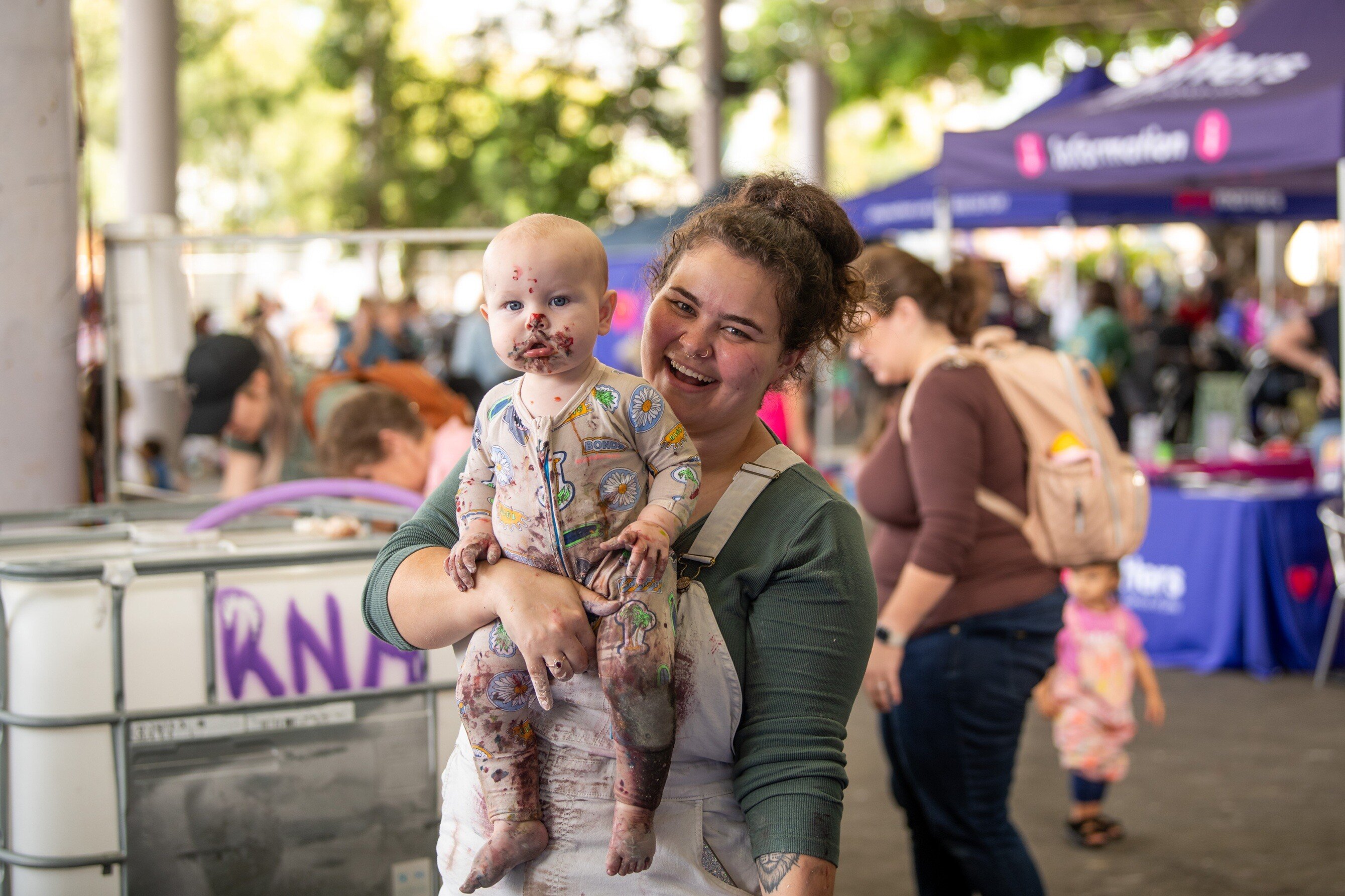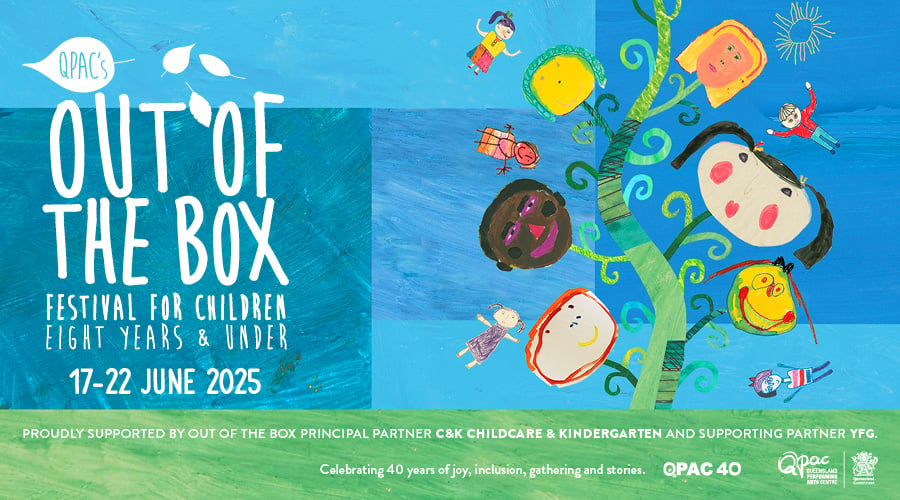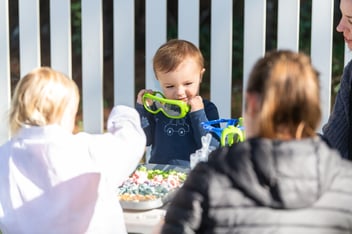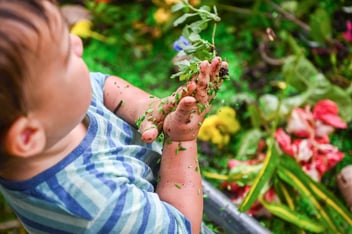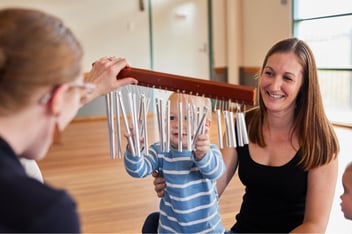
How Singing, Sound, and Rhythm Shape Young Minds
Blog > How Singing, Sound, and Rhythm Shape Young Minds

How Singing, Sound, and Rhythm Shape Young Minds

Music isn't just something we hear - it’s something we feel, move with, create and share.
For young children, music is a sensory tool for understanding the world around them. It's a way to connect, express feelings and build a shared language as children grow. Whether it's the upbeat rhythm of a pop song or the soothing melody of a lullaby, music plays a vital role in early childhood development.
Music can lift our mood, ground us in the present, or take us on a journey through our imagination. It's not just about making noise, it's a way to create meaning. Through music, children explore emotions, build relationships, and lay the foundation for lifelong learning. Let's explore how including music in playtime nurtures the cognitive, emotional, and social development of young children.
How Music Impacts our Brains
Engaging in musical activities (such as singing, playing instruments, or listening to music) stimulates brain development, enhances memory, and supports skills like attention and problem-solving. These experiences also promote spatial-temporal reasoning, which is foundational for mathematics and science learning.
Howard Gardner’s Theory of Multiple Intelligences recognises music as a distinct intelligence, reinforcing its importance in early education and brain development. Through music, children learn to decode complex auditory information, supporting language acquisition and comprehension.
Music Play for Emotional Support and Regulation
Music helps young children explore and express their emotions, making it an ideal tool for emotional regulation. Sensory music experiences help children self-soothe, manage emotions, and transition through daily routines.
For example, familiar lullabies or calming songs can help children relax, feel secure, and prepare for sleep or quiet time. The familiar sound of a parent’s voice singing is especially comforting, strengthening the parent-child bond and providing emotional reassurance.
Music can also be energising or calming, depending on the context and the child’s needs. Using music to help children navigate tricky moments, such as transitions or stressful situations, provides distraction, comfort, and a sense of routine.
Building Relationships Through Music
Shared musical experiences are uniquely effective in building relationships and fostering social skills. Music and movement activities, such as singing, dancing, or playing instruments together, encourage cooperation, teamwork, and meaningful connections between children and adults. These experiences also support turn-taking, sharing, and participating in group activities - key elements of social development.
Intergenerational music play, where children and older adults engage together, is particularly powerful. It bridges generational gaps, creates shared memories, and fosters a sense of belonging and community. Music provides a non-verbal way to connect, making it accessible and enjoyable for everyone, regardless of age or ability. Even simple activities like clapping games, call-and-response songs, or making music with everyday objects can strengthen bonds and facilitate positive interactions.
Why Bring Music Into Play?
- Cognitive Development: Enhances memory, pattern recognition, and problem-solving skills through repetition and musical structure.
- Language Development: Supports vocabulary acquisition, speech fluency, and comprehension through singing and rhythmic activities.
- Emotional Regulation: Helps children self-soothe, manage transitions, and express emotions safely and creatively.
- Social Skills and Relationships: Promotes cooperation, empathy, and connection through shared musical experiences and group activities.
- Physical and Motor Skills: Develops fine and gross motor skills through instrument play, dancing, and movement games.
Practical Ways to Incorporate Music Play into Daily Routines
Sing Together
Incorporating singing into everyday tasks not only makes routine activities more enjoyable but also enhances language skills, memory, and social bonding. Here are a few ideas to add music to your day:
- Singing During Transitions - Use songs to signal changes in routines and transitions, such as a “tidy-up” song when it's time to tidy up or a “getting dressed” song to make the morning routine more fun and signal the change of activity.
- Daily Routine Song - Sing simple, repetitive songs during activities like washing hands, brushing teeth, or putting on shoes. The repetition will help children learn new words and reinforce concepts (e.g., “This is the way we wash our hands…”).
- Interactive Singing - Encourage children to sing along with you or make up their own verses. You can adapt well-known songs to suit your activities, creating an interactive and fun experience.
- Playful Sound Effects - When singing, add sound effects or actions (like clapping, stomping, or mimicking animal sounds) to make the songs more engaging and to incorporate physical movement.
Dance and Move
Movement is essential for young children’s physical and emotional development. Music provides an enjoyable way for children to express themselves through body movement. Consider these ideas to encourage movement:
- Free Dance Time - Play different types of music and encourage children to move in their own way. You can create a mini dance party where children are free to explore different ways of moving to the beat.
- Dance to Express Emotions - Choose music for different moods, such as fast-paced upbeat songs for energetic movement, or slower, calming music for relaxation and calming activities.
- Follow the Leader - Take turns being the "leader" during dancing sessions. One person can come up with a dance move that others must follow, encouraging attention and imitation.
- Action Songs - Use songs that include motions or actions, such as “Head, Shoulders, Knees, and Toes” or “If You’re Happy and You Know It.” These songs teach children body awareness, coordination, and how to follow instructions.
Explore Instruments
Introducing children to musical instruments, both traditional and homemade, helps them learn about sound, rhythm, and coordination. Here are ways to foster instrument exploration:
- Simple Percussion Instruments - Provide access to tambourines, maracas, or drums. Allow children to experiment with different ways of shaking, tapping, and banging, which helps with fine motor skills and rhythm.
- Homemade Instruments - Use simple household items, from shakers made with containers of rice or pasta to drums from pots, pans and a wooden spoon. This can be a fun, creative activity that encourages children to explore the sounds they can create.
- Sound Exploration - Let children explore various materials to see how they create different sounds. For example, hitting a wooden spoon on a wooden surface sounds different from tapping it on a metal surface. This exploration teaches children about texture and sound.
- Group Music Making - Create simple, shared rhythms by playing instruments together. Encourage turn-taking, where each child has a chance to play their instrument, helping them develop social skills like cooperation and listening.
Create Music Together
Making music with everyday objects allows children to connect with their environment in a creative way. It’s also a fantastic opportunity for spontaneous learning and fun. Here are ways to turn ordinary items into musical instruments:
- Kitchen Instruments - Turn kitchen utensils into instruments—use pots, pans, and wooden spoons for drumming or create a xylophone by placing glasses of water at different levels. Try out different objects and see how the sounds change.
- Nature Instruments - Go outdoors and gather items from nature to create sound—stones, sticks, leaves, or even grass can be used to create various textures of sound. This encourages children to interact with the natural world and learn about sound variation.
- Object Exploration - Find objects around the house that can be turned into musical instruments. Empty water bottles filled with beads can make maracas, and a cardboard box can become a drum. This not only promotes creativity but also encourages resourcefulness and problem-solving.
- Sound Matching Games - Play a “sound matching” game where children are given a set of objects that make different sounds. Play the sounds and ask children to match the objects with the correct sound, reinforcing auditory discrimination skills and encouraging focused listening.
Listen to Music
Listening to music from different genres, styles and cultures can help children recognise different sounds, instruments and their musical preferences.
Not sure where to start? The list below is a great starting point for exposing children to new musical styles and supporting their musical development.
ABC Education – Music Hub: A comprehensive collection of curriculum-aligned videos, songs, and interactive activities covering various musical genres and concepts
Let's Sing! – ABC Education: A series of engaging sing-along videos featuring Australian artists, designed to encourage classroom participation and introduce children to different musical styles.
Rhymes and Songs – ABC Education: Video-based music lessons for Foundation to Year 2 students, based on the works of the late Richard Gill AO, focusing on classic children's songs and rhythms.
Sound Makers – ABC Education: A fun collection of videos introducing early primary students to fundamental concepts in music and science, promoting creativity and critical thinking.
ABC Kids Listen App: A dedicated 24/7 digital radio station and on-demand app for children aged 0–5 and their families. It provides a safe, trusted space to access educational and entertaining audio content, including music, stories, and podcasts
Classic Kids: An engaging program that introduces children to classical music through storytelling and interactive activities. It helps develop listening skills and an appreciation for orchestral music.
Soundwalks: Guided audio journeys that combine music, storytelling, and nature sounds to help children relax and connect with their surroundings. Ideal for mindfulness and emotional regulation.
Quiet Time: A collection of tranquil classical music pieces designed to help children wind down and prepare for rest or sleep. Perfect for nap times or calming activities.
Sleep Through: Peaceful soundscapes featuring nature sounds and gentle music to assist children in falling asleep and staying asleep through the night.
By turning everyday moments into musical experiences, children can develop a love for music and engage in play that supports their overall development. Whether you’re singing together, moving to the beat, exploring instruments, or creating sounds with household items, these activities offer endless opportunities for fun, learning, and growth.
Remember, every song sung, every rhythm tapped, and every dance move made contributes to a child's growth and development. So, let's make music a part of every child's day because when children play with music, they play with possibility.
REFERENCES:
Australian Broadcasting Corporation. (n.d.). ABC Kids listen app. ABC Kids. Retrieved May 9, 2025, from https://www.abc.net.au/abckids/abc-kids-listen-app/11131286
Australian Broadcasting Corporation. (n.d.). Classic Kids. ABC Kids Listen. Retrieved May 9, 2025, from https://www.abc.net.au/kidslisten/programs/classic-kids
Australian Broadcasting Corporation. (n.d.). Let's Sing!. ABC Education. Retrieved May 9, 2025, from https://www.abc.net.au/education/collections/lets-sing
Australian Broadcasting Corporation. (n.d.). Music. ABC Education. Retrieved May 9, 2025, from https://www.abc.net.au/education/topic-music/14016880
Australian Broadcasting Corporation. (n.d.). Quiet Time. ABC Kids Listen. Retrieved May 9, 2025, from https://www.abc.net.au/kidslisten/programs/quiet-time/quiet-time/105158738
Australian Broadcasting Corporation. (n.d.). Rhymes and Songs. ABC Education. Retrieved May 9, 2025, from https://www.abc.net.au/education/digibooks/rhymes-and-songs/104217836
Australian Broadcasting Corporation. (n.d.). Sleep Through. ABC Kids Listen. Retrieved May 9, 2025, from https://www.abc.net.au/kidslisten/programs/sleep-through
Australian Broadcasting Corporation. (n.d.). Sound Makers. ABC Education. Retrieved May 9, 2025, from https://www.abc.net.au/education/digibooks/sound-makers/102444256
Australian Broadcasting Corporation. (n.d.). Soundwalks. ABC Kids Listen. Retrieved May 9, 2025, from https://www.abc.net.au/kidslisten/programs/soundwalks
Australian Children's Education & Care Quality Authority. (n.d.). Research and reports. Retrieved May 9, 2025, from https://www.acecqa.gov.au/resources/research
Australian Government Department of Education. (n.d.). Australian Early Development Census. Retrieved May 9, 2025, from https://www.education.gov.au/early-childhood/about/data-and-reports/australian-early-development-census
Australian Institute of Family Studies. (2020). The impact of a music therapy program on parenting capacity and child development outcomes. Retrieved May 9, 2025, from https://aifs.gov.au/resources/short-articles/impact-music-therapy-program-parenting-capacity-and-child-development
Department for Education, South Australia. (n.d.). Making musical instruments. Retrieved May 9, 2025, from https://www.education.sa.gov.au/working-us/playgroups/facilitator-guide/together-activities/activities/making-musical-instruments
Department for Education, South Australia. (n.d.). Music education strategy and music innovation fund. Retrieved May 9, 2025, from https://www.education.sa.gov.au/department/strategies-and-plans/music-education-strategy-and-music-innovation-fund
Gardner, H. (1983). Frames of mind: The theory of multiple intelligences. Basic Books.
Kelly, M. (n.d.). The scientific link between music and brain development. Mini Maestros. Retrieved May 9, 2025, from https://www.minimaestros.com.au/the-scientific-link-between-music-and-brain-development-by-maddy-kelly/
My Teaching Cupboard. (n.d.). Sound discrimination activities: Fun and easy. Retrieved May 9, 2025, from https://www.myteachingcupboard.com/blog/sound-discrimination-activities-fun-and-easy
Play Matters Australia. (n.d.). Music as a form of sensory play. Retrieved May 9, 2025, from https://playmatters.org.au/blog/music-as-a-form-of-sensory-play
Play Matters Australia. (n.d.). Music Play for Early Literacy and Numeracy. Retrieved May 9, 2025, from https://playmatters.org.au/blog/music-play-for-early-literacy-and-numeracy
Play Matters Australia. (n.d.). Music Play Month. Retrieved May 9, 2025, from https://playmatters.org.au/monthly-themes/music-play-month
Play Matters Australia. (n.d.). Nature and music: A perfect harmony. Retrieved May 9, 2025, from https://playmatters.org.au/blog/nature-and-music-a-perfect-harmony
Play Matters Australia. (n.d.). Sensory play. Retrieved May 9, 2025, from https://playmatters.org.au/blog/tag/sensory-play
Play Matters Australia. (n.d.). The benefit of music and movement in Ageless Play playgroups. Retrieved May 9, 2025, from https://playmatters.org.au/blog/the-benefit-of-music-and-movement-in-ageless-play-playgroups
Practical Outcomes. (2024, February 16). The power of music in early childhood education. Retrieved May 9, 2025, from https://practicaloutcomes.edu.au/music-early-childhood-education/
Queensland Government. (n.d.). The many benefits of music. Retrieved May 9, 2025, from https://earlychildhood.qld.gov.au/early-years/early-learning-at-home/encourage/the-many-benefits-of-music
Find a play experience near you:
Subscribe to our newsletter >
Related content:
Advertisement:
.jpg)
